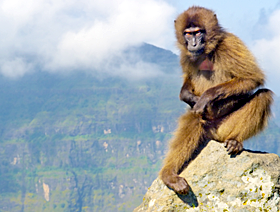
Mount Kenya in central Africa is so high that every day is summer, and every night is winter. The animals and plants must adapt to the brutal conditions in order to survive.
At night, the Giant Groundsel plant tucks its leaves closely together as if wrapping up in a blanket to prevent itself from freezing. Geladas live in these volatile mountains. Their long fur keeps them warm at night whilst they hide in caves, and as the sun rises every morning they climb to the top of the mountain to play.
Each night the water on Mount Kenya freezes, creating a Crystal Kingdom. Yet in the day streams and rivers are vibrant with energy.

 |
What this unit will give you Knowledge to guide your students to complete this project
|
 |
What this project will give your students
|
Stage 1 - Unpacking the Problem
The high mountains of tropical Africa are a unique environment.The Enchanted Kingdom crew filmed on Mount Kenya, which is about 17,000 feet high (5199m) and right on the equator.
At night things change dramatically. Whatever the weather during the day, the skies often clear at night. With clear skies at such a high altitude, temperatures plummet as low as minus 10°C. Frost forms and everything begins to freeze solid. Shallow streams freeze over. Larger ones keep flowing but the splashes and dripping water create many icicles and coat the bankside vegetation with a layer of ice.

|
What you can do
|
|
|
 |
What
you can do
Once testing is finished, groups should be given the opportunity to evaluate their design. This process should be added to the Office Mix journal created during stage 2. |

|
|
 |
What
you can do - Numeracy |
 |
What
you can do |
 |
Reflection Ensure that students have ample rehearsal time to build their confidence. Students who struggle significantly with confidence could present using a partially pre-prepared Office Mix. In order to challenge more
able students, be prepared to take a step back and allow groups
to take ideas and ‘run with them’. They should also
be encouraged to present in an unscripted way, challenging them
to gain and monitor the attention of their audience, interacting
with – and questioning – them. |

|
|

